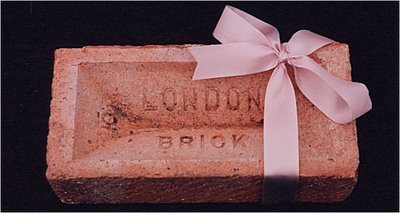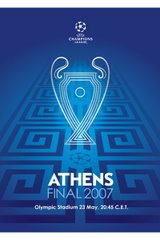House of Mirth
Antoni and Alison are best known as fashion designers but they
have gained recent notoriety as photographers,
with images like that of a brick tied with ribbon.October 8, 2006
By IAIN R. WEBB
To visit the new Web site of the British fashion and design team Antoni Burakowski and Alison Roberts is to enter a parallel world. “Welcome to the house of Antoni & Alison,” the narrator intones as you are taken on a virtual tour of the four-story Georgian town house in newly trendy South London that the pair have spent the last two years renovating as a headquarters and showcase for their work. On the ground floor, the camera pans 360 degrees to reveal polished floorboards and bare brick walls decorated with an ornate gilded mirror, battered brown leather furniture, two standard lamps and a display case filled with woodland figurines. “The house ... is set in a terrace of dilapidated buildings and ... Charles Dickens is believed to have walked past here several times,” the commentary continues. “Please see, on the sofa, a Charles Dickens book.”
This mock National Heritage presentation may be in vogue among London artists like Grayson Perry, whose recent show, “The Charms of Lincolnshire,” was dedicated to the darker side of rural Victorian life and featured genuine and faux-historical artifacts. But it is also typical Antoni & Alison humor. Burakowski and Roberts met in the early 1980’s at St. Martin’s School of Art, where he was studying fashion and she was studying fine art. And while they have been part of the London fashion scene for almost 20 years, they are not what you would call fashion designers.
Their conceptual approach bears comparison to the Dutch designers Viktor & Rolf, while their deadpan, quintessentially British, if not nostalgia-tinged, sensibility puts them shoulder to shoulder with artists like Gilbert and George. Since setting up the business in 1987, Burakowski and Roberts have cultivated their professional marriage, appearing together disguised as goths or, say, donkeys, and even referring to themselves as Mr. & Mrs. Antoni & Alison (in reality they each live with their own partners). Creatively, however, they are inseparable. “That was more important than anything,” says Roberts, whose nunlike modesty plays off Burakowski’s love of the outrageous. “Whatever we put our minds to, we could achieve together.”
At first glance their work is blatantly what-you-see-is-what-you-get, as in their trademark one-word T-shirts, with messages like “Loser” and “Modernist.” Context is key. “Our very first shows, there were no clothes,” Burakowski says. Or not clothes on models anyway: “It was more of an installation thing.”
When they opened a store in 1997, it was not on Bond Street, W1, but on Rosebery Avenue, EC1, next door to a postal sorting office. Called “The Factory of Lights and Experiments,” it featured some of the actual Blackpool Illuminations (the light-display tourist attraction that decorates the seaside town of Blackpool, Britain’s answer to Las Vegas) alongside the stock.
Other fashion presentations have included slide shows and films containing an apparently random jumble of images, often accompanied by a soundtrack of amusing bons mots and surreal observations penned by Roberts.
“A slide show that related to nothing,” Roberts says, explaining that these were made purely for their visual and aural impact. “It was
about things which just happened to excite us at the time.”
Lately, what has excited them is photography. Self-taught and using the roof of a local parking garage as a daylight studio, Burakowski and Roberts are now represented by the respected Photographers’ Gallery in London, their work exhibited worldwide. Their still lifes are purposefully naοve, featuring odd juxtapositions of mundane objects like a house brick tied with a satin ribbon, or a sausage covered in sequins; in a series called “Corrected Masterpieces,” the pair have updated various famous paintings, including Thomas Gainsborough’s “Mr. and Mrs. Andrews,” to which they added a brick.
Antoni & Alison focus on the kind of objects to which other people give little regard. A biscuit or a potato chip might become a print on a skirt, a discarded china figurine given center stage in an artwork. Their latest installation piece, “Cabinet of Curiosities” (originally created for an exhibition in a trendy Clerkenwell hotel and now in their headquarters), features an old cupboard filled with objets d’art that they have used in their photographs. Included in it are a porcelain rabbit ornament with a bandaged ear and a head of lettuce — they seem to never throw anything away. Victoria and Albert Museum’s archive now houses much of their back catalog — from sketches and patterns to utility bills and even a letter from Burakowski’s mother pleading with him to “get a proper job.” Similar items can be found on their Web site (www.antoniandalison.com), along with reissues from previous collections, special limited editions and “souvenirs,” like dish towels, oven gloves and even fabric, all available for purchase.
“The idea of the Web site was our way of making a perfect vision of us,” Burakowski says. While much of their new town house has been stripped to the exposed brickwork, there are lots of incongruous additions, like a black sink that belonged to Sir Billy Butlin, the famous British holiday-camp proprietor; French windows that were taken from the set of a Robbie Williams pop video; and chairs from the ABC theater in Northampton. “They were almost certainly used by the Beatles when they played there in 1963,” the narrator on the Web site helpfully confides. Alongside each item in the house are little brass plaques that tell their story. “They are things that we’ve found and loved and kept,” Burakowski says.
Adds Roberts, “Putting them back together again in the wrong place makes them modern.”
At first glance their work is blatantly what-you-see-is-what-you-get, as in their trademark one-word T-shirts, with messages like “Loser” and “Modernist.” Context is key. “Our very first shows, there were no clothes,” Burakowski says. Or not clothes on models anyway: “It was more of an installation thing.”
When they opened a store in 1997, it was not on Bond Street, W1, but on Rosebery Avenue, EC1, next door to a postal sorting office. Called “The Factory of Lights and Experiments,” it featured some of the actual Blackpool Illuminations (the light-display tourist attraction that decorates the seaside town of Blackpool, Britain’s answer to Las Vegas) alongside the stock.
Other fashion presentations have included slide shows and films containing an apparently random jumble of images, often accompanied by a soundtrack of amusing bons mots and surreal observations penned by Roberts.
“A slide show that related to nothing,” Roberts says, explaining that these were made purely for their visual and aural impact. “It was
about things which just happened to excite us at the time.”
Lately, what has excited them is photography. Self-taught and using the roof of a local parking garage as a daylight studio, Burakowski and Roberts are now represented by the respected Photographers’ Gallery in London, their work exhibited worldwide. Their still lifes are purposefully naοve, featuring odd juxtapositions of mundane objects like a house brick tied with a satin ribbon, or a sausage covered in sequins; in a series called “Corrected Masterpieces,” the pair have updated various famous paintings, including Thomas Gainsborough’s “Mr. and Mrs. Andrews,” to which they added a brick.
Antoni & Alison focus on the kind of objects to which other people give little regard. A biscuit or a potato chip might become a print on a skirt, a discarded china figurine given center stage in an artwork. Their latest installation piece, “Cabinet of Curiosities” (originally created for an exhibition in a trendy Clerkenwell hotel and now in their headquarters), features an old cupboard filled with objets d’art that they have used in their photographs. Included in it are a porcelain rabbit ornament with a bandaged ear and a head of lettuce — they seem to never throw anything away. Victoria and Albert Museum’s archive now houses much of their back catalog — from sketches and patterns to utility bills and even a letter from Burakowski’s mother pleading with him to “get a proper job.” Similar items can be found on their Web site (www.antoniandalison.com), along with reissues from previous collections, special limited editions and “souvenirs,” like dish towels, oven gloves and even fabric, all available for purchase.
“The idea of the Web site was our way of making a perfect vision of us,” Burakowski says. While much of their new town house has been stripped to the exposed brickwork, there are lots of incongruous additions, like a black sink that belonged to Sir Billy Butlin, the famous British holiday-camp proprietor; French windows that were taken from the set of a Robbie Williams pop video; and chairs from the ABC theater in Northampton. “They were almost certainly used by the Beatles when they played there in 1963,” the narrator on the Web site helpfully confides. Alongside each item in the house are little brass plaques that tell their story. “They are things that we’ve found and loved and kept,” Burakowski says.
Adds Roberts, “Putting them back together again in the wrong place makes them modern.”
A sausage covered in sequins.
(Brexians lair)










Δεν υπάρχουν σχόλια:
Δημοσίευση σχολίου